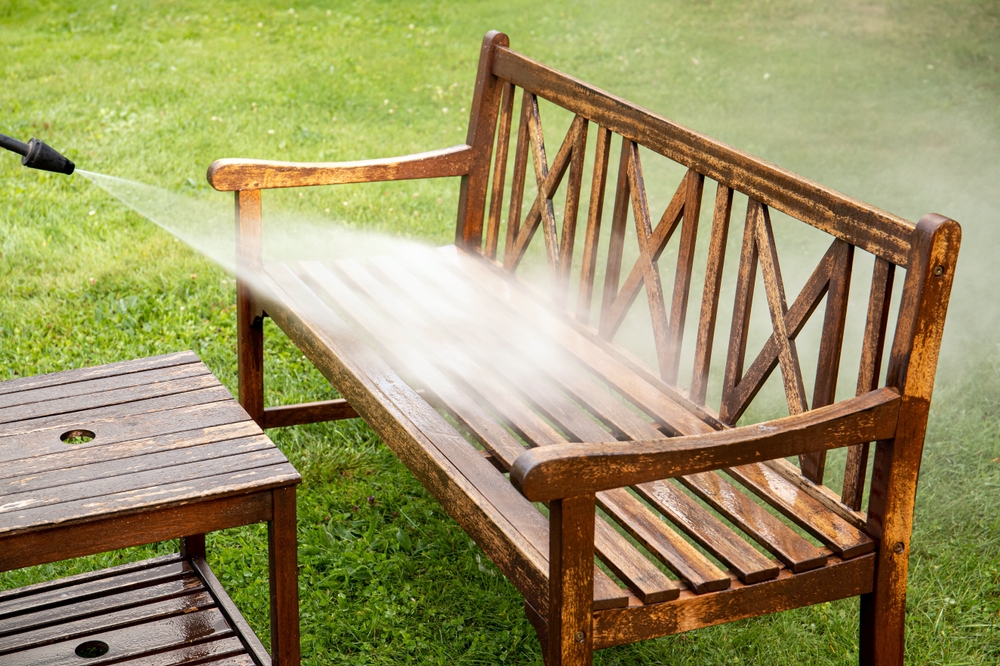
Wicker and rattan furniture bring natural texture, warmth, and charm to patios, porches, and sunrooms. These materials are lightweight, flexible, and stylish—making them a favorite for both indoor and outdoor seating. But when it comes time to clean them, power washing is not the solution. 🚫💦
Despite how tempting it might be to blast away dust, mildew, or grime with a pressure washer, doing so can cause irreversible damage to wicker and rattan. In this guide, we’ll explore why these materials are so vulnerable and how to safely clean them without compromising their structure or beauty.
🪑 What Is Wicker? What Is Rattan?
Many people confuse the two:
- Rattan is a natural vine-like plant that is strong and flexible, commonly used to make furniture.
- Wicker refers to the weaving technique used, which may be made from rattan, bamboo, willow, or even synthetic resin.
Both materials are often used interchangeably in furniture manufacturing, but traditional wicker and rattan are porous, delicate, and not built to withstand high-pressure water.
⚠️ Why Power Washing Is a Bad Idea
Power washers, even on a lower PSI setting, can:
- Fray or unravel the weave
- Snap brittle pieces of rattan or wicker strands
- Force water into crevices, leading to mold and rot
- Strip off protective coatings or paint
- Loosen joints and structural supports
Once water gets inside the material or weakens the weave, you may start to see sagging, cracking, and deterioration—not the kind of rustic charm you want! 🛠️😬
💧 “But What About Synthetic Wicker?”
Synthetic wicker (typically made from resin or vinyl) is more durable and can tolerate light power washing if handled carefully.
However:
- Always test on a small area first
- Use a wide-angle tip (40°)
- Keep pressure below 1,200 PSI
- Maintain a distance of 2–3 feet
- Avoid high-pressure rinsing around legs, joints, and corners
Even synthetic materials can loosen or crack if sprayed too aggressively.
🧼 Safe Cleaning Methods for Wicker and Rattan
Here’s how to clean these materials the right way—without risking damage.
✅ Step-by-Step for Natural Wicker or Rattan
- Vacuum First 🧹
Use a vacuum with a brush attachment to remove loose dirt, dust, and cobwebs. - Dry Brush the Surface 🖌️
Use a soft bristle brush to gently loosen grime from the weave. - Mix a Gentle Cleaning Solution
Combine warm water and a few drops of mild dish soap or white vinegar. - Wipe with a Damp Cloth 🧽
Dip a cloth in the soapy solution and wring it out well. Wipe the surface gently. - Use a Toothbrush for Tight Spots 🪥
An old toothbrush works wonders for detail cleaning in the woven crevices. - Rinse Lightly
Use a second damp cloth (with clean water only) to remove soap residue. - Dry Completely ☀️
Set furniture in the sun or use a fan. Never let wicker stay damp—it encourages rot and mildew.
✅ Cleaning Synthetic Wicker
You can use a garden hose with moderate pressure, or a soft brush and soap. Avoid harsh chemicals and don’t let water pool in the furniture frame.
🧼 Tip: Clean synthetic wicker in the morning so it has all day to dry out in the sun.
🚫 Common Mistakes to Avoid
❌ Power washing any natural wicker or raw rattan
❌ Letting water sit or soak into the material
❌ Using bleach, ammonia, or harsh cleaners
❌ Storing damp furniture in enclosed spaces
❌ Dragging furniture across concrete, which wears down legs and joints
🌧️ How to Protect Wicker & Rattan from the Elements
These materials should be protected from rain and moisture. Here’s how:
- Keep under a covered patio or awning
- Use waterproof covers when not in use
- Store indoors or in a shed during winter
- Reapply sealant or varnish once a year
- Use cushions with waterproof bottoms to reduce water absorption
Proper care dramatically extends the lifespan of your furniture.
👷 When to Call a Pro
Hire a professional cleaner if:
- Your pieces are antique, fragile, or heirloom-quality
- There’s deep mold or mildew you can’t remove
- Paint or sealant needs to be stripped and reapplied
- You’re unsure whether the furniture is natural or synthetic
A pro will know what can be safely cleaned—and what requires restoration.
🧽 Final Thoughts
Wicker and rattan furniture may look rugged and rustic, but they’re not built for high-pressure cleaning. Power washing will almost always do more harm than good. With a little elbow grease, the right tools, and gentle care, you can keep your woven furniture looking beautiful season after season—without blasting it into a splintered mess. 🪑🌿🧼



